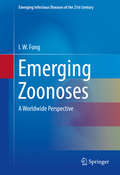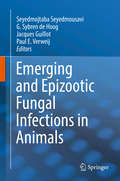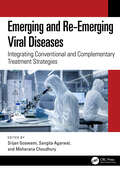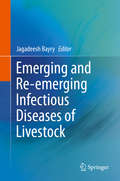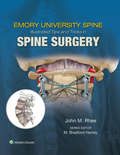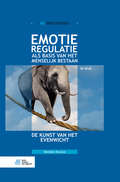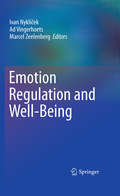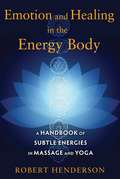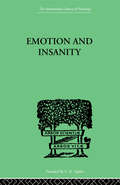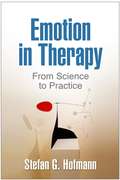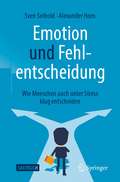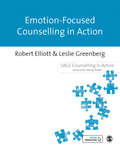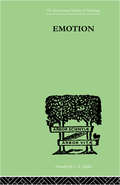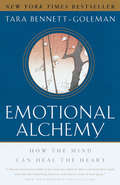- Table View
- List View
Emerging Values in Health Care: The Challenge for Professionals
by Huw Thomas Brian Hurwitz Derek Sellman Ben Hannigan Roisin Pill Chris Swift Stephen Pattison Paul Ballard Heather Skirton Moira Dumma Lynn Knight Kieran Sweeney Julia Mckeown Alan Nathan Chrissie Hockley Andrew Edgar Bronwen Davies Srikant Sarangi David Badcott Paquita De ZuluetaProfessional values in healthcare are in a state of constant and increasingly rapid change. While all professions now emphasise teamwork and collegiality in practice, fewer are inclined to consider shared or differing values across professions. This interdisciplinary volume explains how health care professions and their values have changed over the last forty years, charting where they have come from, where they are now, and how they might develop in the future. There is coverage of a wide range of different professions within healthcare, from GPs, mental health nurses, adult nurses and pharmacists, to NHS managers and chaplains. Chapters are followed by critical responses from senior healthcare practitioners. This original and insightful book will be a valuable resource for academics, researchers, senior healthcare professionals and healthcare managers.
Emerging Viral Diseases: Workshop Summary
by Eileen R. ChoffnesIn the past half century, deadly disease outbreaks caused by novel viruses of animal origin - Nipah virus in Malaysia, Hendra virus in Australia, Hantavirus in the United States, Ebola virus in Africa, along with HIV (human immunodeficiency virus), several influenza subtypes, and the SARS (sudden acute respiratory syndrome) and MERS (Middle East respiratory syndrome) coronaviruses - have underscored the urgency of understanding factors influencing viral disease emergence and spread. "Emerging Viral Diseases" is the summary of a public workshop hosted in March 2014 to examine factors driving the appearance, establishment, and spread of emerging, re-emerging and novel viral diseases; the global health and economic impacts of recently emerging and novel viral diseases in humans; and the scientific and policy approaches to improving domestic and international capacity to detect and respond to global outbreaks of infectious disease. This report is a record of the presentations and discussion of the event.
Emerging Viruses in Latin America: Contemporary Virology (The Latin American Studies Book Series)
by Flor H. Pujol Alberto E. Paniz-MondolfiLatin America has extensive microbial diversity and is endemic for a wide array of infectious agents including dengue, chikungunya, malaria and tuberculosis. In 2014, the WHO cited 93 public health events of potential international concern in the Latin American region where over half (47 events) were caused specifically by chikungunya and other zoonotic pathogens, causing geographically widespread impact affecting 27 countries and territories. Arena, alpha and flaviviruses are RNA viruses, many of which are endemic in South America, are diverse in nature, and can adapt easily to new hosts, creating zoonotic threats. Since more than 70% of emerging diseases are caused by zoonotic agents, it is of great importance to enhance the capacity for detection and diagnosis in the areas where they are most likely to emerge. COVID-19 provided an opportunity to reinforce public health capacities, improve reporting transparency, and enhance regional coordination. Limited but consistent research has been carried out in the region to address the viral threats that account for a significant portion of health concerns. This book describes relevant examples of these achievements and discusses ongoing limitations in the region.
Emerging Zoonoses
by I. W. FongThe book begins with a review of zoonotic pandemics of the past: the "Black Death" or bubonic plague of the Middle Ages, the Spanish Influenza pandemic (derived from avian influenza) of the early 20th century, to the more modern pandemic of AIDS/HIV infection, which originated in Africa from primates. However, the majority of chapters focus on more recent zoonoses, which have been recognized since the late 20th century to the present: #65533; SARS and MERS coronaviruses #65533; New avian influenza viruses #65533; The tick-borne Henan fever virus from China #65533; The tick-borne Heartland virus from the United States #65533; Recently recognized bacterial pathogens, such as Streptococcus suis from pigs. In addition, reemergence of established zoonoses that have expanded their niche are reviewed, such as the spread of Zika virus and Chikungunya virus to the Western Hemisphere, and the emergence and spread of Ebola virus infection in Africa. A chapter is also devoted to an overview of the mechanisms and various types of animals involved in the transmission of diseases to humans, and the potential means of control and prevention. Many endemic and sporadic diseases are still transmitted by animals, through either direct or indirect contact, and zoonoses are estimated to account for about 75% of all new and emerging infectious diseases. It is predicted by public health experts that the next major pandemic of infectious disease will be of animal origin, making Emerging Zoonoses: A Worldwide Perspective a crucial resource to all health care specialists by providing them with much needed information on these zoonotic diseases. iv>
Emerging Zoonotic Threats from Swine: A Public Health Perspective
by Rajib Deb Jitendrakumar Nayak Gyanendra Singh Sengar Vivek Kumar GuptaThis textbook provides insights into emerging zoonotic threats from swine, covering the fundamentals of swine biology to the complexities of zoonotic disease transmission. It includes information on both the emergence and impact of swine health on public well-being. Each chapter is supplemented with prevention and control strategies, addressing the impact of swine-borne viruses on human health. A separate chapter addresses the impact of farming practices on public health and the one-health approach, emphasizing the interconnectedness of swine, humans, and the environment. The textbook also discusses surveillance and monitoring techniques for detecting zoonotic diseases in swine populations, highlighting threats posed by pathogens such as Swine influenza, Nipah virus, and Streptococcus suis. Further chapters emphasize emerging viruses, parasitic worms, and bacterial infections. Additionally, it covers the role of vaccination, diagnostic techniques, and biosecurity measures in controlling and mitigating these diseases, while also addressing the importance of risk communication and education in raising awareness. This textbook is relevant for veterinarians, researchers, policymakers, and public health professionals alike, providing insights into the intersection of swine health and public health. It also serves as a resource for professionals seeking to understand and address the challenges of swine zoonoses.
Emerging and Epizootic Fungal Infections in Animals
by Seyedmojtaba Seyedmousavi G. Sybren de Hoog Jacques Guillot Paul E. VerweijThis book provides in-depth insights into epidemic and emerging mycoses in various animal groups. The different categories of pathogens and outbreak fungi are discussed. In an introductory chapter, the reader will be provided basic information on fungal infections that are non-transmissible, infections from a common environmental source known as sapronoses, and zoophilic fungal pathogens in various animal species and populations, worldwideChapter 2 details the vocabulary and terminology that is required in the scientific literature in order to maintain clarity of expression to the field of Mycology. Chapters 3 to 9 discuss epidemic mycoses with a reservoir in animals and occasional outbreaks, including dermatophytoses, coccidioidomycosis, histoplasmosis, paracoccidioidomycosis, adiaspiromycosis and similar diseases, blastomycosis, and paracoccidioidomycosis ceti (lacaziosis/lobomycosis). Chapters 10 to 15 comprise emerging mycoses in animals that include feline sporotrichosis, lethargic crab disease, emergence of C. gattii in animals and zoonotic potential, white-nose syndrome in hibernating bats, chytridiomycosis in frogs and salamanders and aspergillosis in cats. The last chapter is about treatment possibilities, antifungal use in veterinary practice, and emergence of resistance. The book will address medical and veterinary mycologists, microbiologists, veterinarians, infectious disease specialists, epidemiologists, ecologists, public health scientists from academia and industry as well as graduate students, PhD students and postdocs in the field.
Emerging and Evolving Topics in Multiple Sclerosis Pathogenesis and Treatments
by Anne C. La Flamme Jacqueline Monique OrianOver the past decade, we have made great advances in the field of multiple sclerosis (MS) research, and this book focuses on those advances in MS pathogenesis and treatment. While some of these advances have been through new approaches and ideas that have emerged in the last decade such as the newly identified protective role that amyloid proteins may play in MS or the use of helminths to treat autoimmune diseases, others have evolved from previous theories and ideas that have only now gained momentum and a deeper understanding such as the role of HLA or gender in MS susceptibility. This book covers these emerging and evolving topics and highlights the substantial advancements made in elucidation of the factors regulating susceptibility or disease progression, identification of new ways to monitor or predict MS pathology, and development of new strategies for treating MS.
Emerging and Innovative Arsenic Removal Technologies for a Sustainable Future (Water Science and Technology Library #131)
by Akhilesh Kumar Yadav Saba ShirinThis book presents an overview of the techniques available today to remove arsenic contamination, pollutants, and species from water. Traditionally applied techniques for removal of arsenic pollutants/species, including oxidation, coagulation-flocculation, and membrane techniques. Furthermore, recent progress has been made on the utility of various nanoparticles for the extraction of contaminated water. Arsenic contamination affects the quality of water resources worldwide as a result of human activities (pesticides and other uses). Due to the insufficiency of water treatment facilities in developing countries, oral exposure to chemical toxicants through drinking water is a health threat. Arsenic is a mobile element with a crustal abundance of 1.8 mg kg-1 and can travel in different components of the environment, including air, soil, and water before entering into its ultimate sink, that is, bottom sediments and sea. Arsenic may enter groundwater from both geogenic and anthropogenic sources and primarily exists in inorganic form as oxy-anions. Groundwater is relatively more vulnerable to arsenic contamination from geothermal inputs, including the weathering and dissolution of arsenic-bearing rocks and minerals. Arsenic mobility is enhanced in subsurface anoxic conditions, making groundwater more vulnerable to arsenic contamination. Ingestion of groundwater-laden arsenic may cause carcinogenic and non-carcinogenic health ailments. Chronic oral exposure ≤ 50 µg L-1 of arsenic can cause skin lesions, skin cancer, melanosis, hyperkeratosis, hypertension, gangrene, cardiovascular problems, black foot disease, neuropathy, peripheral vascular disease, restrictive lung disease, bladder cancer, lung cancer etc. Hence, specific water treatment processes are required to meet anticipated more severe water quality standards. A better understanding of currently available processes is necessary to develop economical, efficient and effective methods for arsenic removal. Arsenic can be coated, adsorbed using a wide range of mineral and organic or can be directly rejected by membrane processes such as reverse osmosis and nanofiltration. The recent development of submerged hybrid membrane systems, such as membrane bioreactors in wastewater treatment, provides alternative technologies for arsenic treatment.
Emerging and Re-Emerging Viral Diseases: Integrating Conventional and Complementary Treatment Strategies
by Srijan Goswami Moharana Choudhury Sangita AgarwalThis reference book offers an in-depth analysis of the fundamental aspects, causative agents, and clinical manifestations of emerging and re-emerging infectious diseases of viral origin (EID-REID). It elucidates the role of evolutionary processes in the emergence, adaptation, and dissemination of pathogens. The initial chapter explores the causative agents behind EID-REID, providing a comprehensive overview of their origins, characteristics, and modes of transmission. The book further presents the structure, pathophysiology, and clinical presentation of various viral pathogens, including notable viruses such as the Crimean-Congo hemorrhagic fever Orthonairovirus (CCHFV), Rift Valley fever virus, Lassa virus, Nipah virus (NiV), Filoviridae, and coronaviruses (MERS, SARS, SARS-CoV-2). Additionally, the book elucidates the multifaceted landscape of treatment strategies, highlighting the pivotal role of pharmacological strategies, investigational drugs, vaccines, and immunomodulatory approaches. It also underscores the importance of clinical examination, immunoassays, and molecular diagnostic techniques for the early detection and accurate diagnosis of viral EID-REID. Toward the end, the book sheds light on the pivotal role of the Ayurveda, homoeopathic system of medicine, medical nutrition therapy, computational biology, bioinformatics, and systems biology in advancing disease management paradigms. This book is intended for epidemiologists, virologists, infectious disease specialists, and other healthcare practitioners who seek in-depth knowledge about emerging and re-emerging infectious diseases.
Emerging and Re-emerging Infections in Travellers
by Nick Beeching Eskild Petersen Hakan LeblebiciogluThis book provides essential information on the epidemiology, diagnosis and management of common and some rare infections in travellers. It will equip readers with key knowledge on clinically important emerging and re-emerging infections caused by wide variety of bacteria, viruses and parasites. The coverage ranges from influenza, hepatitis, malaria and tuberculosis to Ebola virus disease, Lassa fever, Crimean Congo haemorrhagic fever, dengue, Zika virus infection and many other important diseases. The emergence and spread of antimicrobial-resistant microorganisms is discussed, and practical advice is included regarding disease prevention in travellers and humanitarian aid workers. Other generic chapters address the clinical approach to fever in the returning traveller, and preparedness and response to emerging infectious diseases. This comprehensive, up-to-date book will be an excellent source of information and guidance for all clinicians and researchers with an interest in infectious diseases, microbiology, epidemiology, and travel medicine.
Emerging and Re-emerging Infectious Diseases of Livestock
by Jagadeesh BayryThis book provides comprehensive knowledge on diseases in livestock that are caused by viruses, parasites and bacteria. Emerging and re-emerging pathogens are presented in detail for various animal groups and in-depth insights into pathogenesis and epidemiology will be provided for each of them. In addition, state-of-the-art treatment possibilities, control measures as well as vaccination strategies are discussed. The recent years have witnessed a sharp increase in the number of emerging and re-emerging infectious diseases of livestock and many of these, including Influenza, Corona and Hanta are of public health importance. The reasons for this development are manifold:changes in the climate, life cycle of vectors and increased global travel. Also, due to extensive deforestation, livestock are increasingly coming in direct contact with wild animals that are reservoirs of many emerging pathogens. Recent progress in diagnosis and management of emerging infectious diseases are also topic of this book.
Emerging and Transboundary Animal Viruses (Livestock Diseases and Management)
by Yashpal Singh Malik Raj Kumar Singh Mahendra Pal YadavThis book, which is the first volume of the book series-Livestock Diseases and Management, summarizes the prominence and implications of the emerging and transboundary animal viruses. Although the livestock plays an important role in the economy of many countries, the emerging and transboundary animal viral diseases possess a serious risk to the animal-agriculture sector and food security globally. The book describes the precise and up-to-date information on animal viral diseases which have emerged in the recent past or are re-emerging due to various environmental factors and those which are not bounded in restricted national boundaries and attained the transboundary status. The chapters summarize the recent advancements in the molecular state-of-art tools towards the development of diagnostics, prophylactics, and therapeutics of these viruses. It also explicitly describes the challenges imposed by the emerging and transboundary viral infections and our preparedness to counter them.
Emory's Illustrated Tips and Tricks in Spine Surgery
by John RheePart of the popular Tips and Tricks series, Emory Spine: Illustrated Tips and Tricks in Spine Surgery provides succinct and practical advice acquired from years of expert practice in spine surgery. Led by John M. Rhee, MD from the Emory University Department of Orthopaedic Surgery and Emory University Spine Fellowship, this visually stunning reference focuses exclusively on detailed descriptions of technical tips and tricks for all aspects of spine surgery. This unique approach will be highly useful to everyone from orthopaedic and neurosurgery spine fellows and residents, to practicing spinal surgeons – anyone who would benefit from exposure to the wisdom that experienced attending surgeons pass on to those who are training or working in this complex field.
Emotieregulatie als basis van het menselijk bestaan: de kunst van het evenwicht
by Nelleke J. NicolaiEmotieregulatie is een primaire levensvoorwaarde, niet minder belangrijk dan eten en drinken. Tegenover comfortabele emoties als blijdschap en geluk staan immers ook emoties als afgunst, angst, jaloezie, schaamte, schuld, verdriet, walging en woede. Daar moet een mens mee zien om te gaan. En dat maakt ‘helpen bij emotieregulatie’ bijna synoniem aan ‘psychotherapie’. Wie er gewoonlijk in slaagt om positief met zijn emoties om te gaan, is evenwichtig. Maar er zijn eindeloos veel omstandigheden denkbaar waarin het evenwichtsgevoel faalt. De kunst van dat evenwicht bewaren, kan door iedereen getraind worden, al dan niet geholpen door een coach of hulpverlener. In dit boek beschrijft Nelleke Nicolai het alfa en omega van emotieregulatie. Ze maakt daarbij onderscheid tussen affecten (onbewuste reacties op externe prikkels), emoties (deels bewuste en deels onbewuste reacties op prikkels) en gevoelens (emoties waaraan actief een betekenis wordt toegekend).
Emotion Regulation and Psychopathology
by Denise Sloan Ann KringRegardless of their specific diagnosis, many people seeking treatment for psychological problems have some form of difficulty in managing emotional experiences. This state-of-the-art volume explores how emotion regulation mechanisms are implicated in the etiology, development, and maintenance of psychopathology. Leading experts present current findings on emotion regulation difficulties that cut across diagnostic boundaries and present psychotherapeutic approaches in which emotion regulation is a primary target of treatment. Building crucial bridges between research and practice, chapters describe cutting-edge assessment and intervention models with broad clinical utility, such as acceptance and commitment therapy, mindfulness-based therapy, and behavioral activation treatment.
Emotion Regulation and Well-Being
by Marcel Zeelenberg Ivan Nyklíček Ad VingerhoetsEmotion is a basic phenomenon of human functioning, most of the time having an adaptive value enhancing our effectiveness in pursuing our goals in the broadest sense. Regulation of these emotions, however, is essential for adaptive functioning, and suboptimal or dysfunctional emotion regulation may even be counterproductive and result in adverse consequences, including a poor well-being and ill health. This volume provides a state-of-the art overview of issues related to the association between emotion regulation and both mental and physical well-being. It covers various areas of research highly relevant to both researchers in the field and clinicians working with emotion regulation issues in their practice. Included topics are arranged along four major areas: * (Neuro-)biological processes involved in the generation and regulation of emotions * Psychological processes and mechanisms related to the link between emotion regulation and psychological well-being as well as physical health * Social perspective on emotion regulation pertaining to well-being and social functioning across the life span * Clinical aspects of emotion regulation and specific mental and physical health problems This broad scope offers the possibility to include research findings and thought-provoking views of leading experts from different fields of research, such as cognitive neuroscience, clinical psychology, psychophysiology, social psychology, and psychiatry on specific topics such as nonconscious emotion regulation, emotional body language, self-control, rumination, mindfulness, social sharing, positive emotions, intergroup emotions, and attachment in their relation to well-being and health. Chapters are based on the "Fourth International Conference on the (Non) Expression of Emotions in Health and Disease" held at Tilburg University in October 2007. In 2007 Springer published "Emotion Regulation: Conceptual and Clinical Issues" based on the Third International Conference on the (Non) Expression of Emotion in Health and Disease," held at Tilburg University in October 2003. It is anticipated that, depending on sales, we may continue to publish the advances deriving from this conference.
Emotion and Healing in the Energy Body: A Handbook of Subtle Energies in Massage and Yoga
by Robert HendersonA comprehensive guide to emotional blockages in the energy body and their physical manifestations • Details how emotional trauma, long-term stress, and environmental influences cause energy blockages in the subtle body that affect the physical body • Explores more than 30 specific physical ailments, detailing the energetic origins of each condition and which meridians, chakras, and points are affected • Explains how to interpret and work with energies released in massage and during yoga practice In this comprehensive guide to subtle energy and its associated physical manifestations, Robert Henderson reveals how the discomfort and pain you carry in your physical body is related to the energies of the life you have experienced. The author explains the eight types of subtle energy: Emotional, which carries anger, fear, love, and other emotions; Mental, which affects patterns of behavior, beliefs, actions, and memories; Spiritual, which influences intuition, inspiration, and transcendent states; Sexual, which affects creativity, spontaneity, and excitement; Environmental, which arises from stress at work, tension at home, and other outside influences; Interpersonal, which comes from interactions with family, lovers, and friends; Ancestral, the energy of the lives of your parents up to the time of your conception; and Karmic, the energy of your past lives. Detailing how these energies are drawn in by the chakras and distributed throughout the body by the meridians, the author explains how suffering acute emotional trauma or long-term stress causes negative energies to accumulate in the energy body much like fat deposits. Our physical body reacts to these energy blockages, leading to physical conditions such as closed hips, tight hamstrings, digestive distress, chronic pain, and persistent tension in areas like the shoulders. The author explores more than 30 specific physical ailments, providing the energetic origins of each condition, the exact location of the corresponding energy blockage, and which meridians, chakras, and points are affected. He covers sexual energy in depth, explaining how to handle repressed energy as it is released during yoga or massage. As the author shows, physical ailments caused by the energies of hurtful life events can be healed through massage and yoga, allowing you to become open to the free and spontaneous circulation of energy through the subtle body.
Emotion and Insanity (International Library Of Psychology)
by Thalbitzer, SFirst published in 1999. Routledge is an imprint of Taylor & Francis, an informa company.
Emotion in Therapy
by Steven C. Hayes Stefan G. HofmannGrounded in cutting-edge scientific research, this book presents innovative ways to explore and work with emotions in psychotherapy. Preeminent clinician-researcher Stefan G. Hofmann accessibly explains how emotions operate, what influences them, and how they can cause distress. He presents strategies that can significantly improve existing evidence-based treatments and promote positive affect and happiness. Clinicians are guided to help clients with any diagnosis gain emotional awareness and use emotion regulation techniques, mindfulness-based practices, and other effective strategies. "In Practice" features highlight specific clinical issues and offer illustrative case vignettes.
Emotion und Fehlentscheidung: Wie Menschen auch unter Stress klug entscheiden
by Alexander Horn Sven SeiboldDieses Sachbuch zeigt Ihnen, welche Logik unseren Entscheidungen zugrunde liegt – und wie Fehlentscheidungen entstehen. Sie lesen zur Veranschaulichung spannende Beispiele aus Politik und Zeitgeschehen sowie aus dem Alltag. Die Ergebnisse und Schlüsse sind sowohl im Beruf wie im Privaten für Sie nutzbar. Allerdings: Es ist anstrengend, gute Entscheidungen zu treffen. Man muss dem inneren Schweinehund entgegentreten und sich zum Denken zwingen, selbst wenn man das nicht möchte und sich das vielleicht auch nicht zutraut. Kommen Sie mit auf eine Entdeckungsreise. Aus dem Inhalt: Situationen – was Entscheiden schwer macht * Emotionen – schlechter als ihr Ruf * Denken – ist anstrengend, hilft aber * Fakten, Wahrnehmungen und Hypothesen * Rekonstruktion – man muss eine Situation verstehen * Gut entscheiden – der rote Faden * Wenn es darauf ankommt – machen Sie es wie Petrow * Nachwort – Persönlichkeit, Führung und die Anderen. Über die Autoren: Sven Seibold ist Psychologe und Professor für Wirtschaftspsychologie; berät Unternehmen in Verdachtsfällen von Mobbing, Burn-out, Wirtschaftskriminalität und Wirtschaftsspionage. Alexander Horn ist Kriminalrat beim Polizeipräsidium München, Leiter der Operativen Fallanalyse Bayern, Experte für schwierige polizeiliche Ermittlungen. Beide haben intensiv zu Entscheidungsverhalten in Extremsituationen geforscht und fanden die Ergebnisse so alltagsrelevant, dass sie diese hier praxisnah darstellen.
Emotion-Focused Counselling in Action (Counselling in Action series)
by Robert Elliott Leslie GreenbergThis is the definitive introduction to the theory and practice of emotion-focused counselling. Starting with an introduction to the main theory and concepts, it then guides you through the counselling phases from beginning to end. The final chapter extends your learning by examining different client populations, process research, and ways of monitoring your practice. Chapters include features such as case studies and transcripts, further reading sections and reflective exercises that help you to enhance your understanding of the approach.
Emotion-Focused Counselling in Action (Counselling in Action series)
by Robert Elliott Leslie GreenbergThis is the definitive introduction to the theory and practice of emotion-focused counselling. Starting with an introduction to the main theory and concepts, it then guides you through the counselling phases from beginning to end. The final chapter extends your learning by examining different client populations, process research, and ways of monitoring your practice. Chapters include features such as case studies and transcripts, further reading sections and reflective exercises that help you to enhance your understanding of the approach.
Emotion: A COMPREHENSIVE PHENOMENOLOGY OF THEORIES AND THEIR MEANINGS for
by Hillman, JamesThis is Volume XIV of thirty-eight in a series on the General Psychology. Originally published in 1960, this study offers A Comprehensive Phenomenology of Theories and their Meanings for Therapy.
Emotional Alchemy: How the Mind Can Heal the Heart
by Tara Bennett-GolemanAlchemists sought to transform lead into gold. In the same way, says Tara Bennett-Goleman, we all have the natural ability to turn our moments of confusion or emotional pain into insightful clarity. Emotional Alchemymaps the mind and shows how, according to recent advances in cognitive therapy, most of what troubles us falls into ten basic emotional patterns, including fear of abandonment, social exclusion (the feeling we don't belong), and vulnerability (the feeling that some catastrophe will occur). Through the simple practice of mindfulness taught in this book, we can free ourselves of such patterns and replace them with empathy for ourselves and others, as well as the freedom to be more creative and alive. You'll find the very latest research in neuroscience--including the neurological "magic quarter second," during which it is possible for a thought to be "caught" before it turns into an emotional reaction. And you'll discover the fascinating parallels of this science with the wisdom of ancient Buddhism--for Buddhists knew centuries ago that we can end our self-destructive habits. This remarkable book also teaches the practice of mindfulness, an awareness that lets us see things as they truly are without distortion or judgment, giving the most insightful explanation of how mindfulness can change not only our lives, but the very structure of our brains. Here is a beautifully rendered work full of Buddhist wisdom and stories of how people have used mindfulness to conquer their self-defeating habits. The result is a whole new way of approaching our relationships, work, and internal lives.



